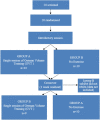German volume training for health promotion: Acute vasopressor, pulmonary and metabolic responses
- PMID: 36601344
- PMCID: PMC9806216
- DOI: 10.3389/fphys.2022.1025017
German volume training for health promotion: Acute vasopressor, pulmonary and metabolic responses
Abstract
Resistance training (RT) is increasingly recommended for incorporation into comprehensive fitness or "exercise as medicine" programs. However, the acute effects of RT, and especially its different sub-types, and how they impact health outcomes are not fully investigated. This study evaluated German Volume Training (GVT) ("10 set × 10 rep scheme") for its efficacy for its use in health settings. This study utilized a randomized crossover design with subjects serving as their own controls to establish baseline values. Subjects were blinded to the study hypothesis. Subjects performed a single session of GVT or no exercise, in a randomised order separated by a 1-week washout period. Outcomes were assessed before and immediately post-exercise. GVT significantly (p < 0.05) decreased systolic blood pressure (SBP), diastolic blood pressure (DBP) and mean arterial pressure (MAP), but increased heart rate (HR), rate pressure product (RPP) and rating of perceived exertion (RPE). No changes were found in the measured spirometry parameters. Increases were observed in carbon dioxide production (VCO2) and minute ventilation (VE), but not respiratory exchange ratio. Post hoc analysis demonstrated that post-GVT values were significantly lower for SBP (p = 0.017; d = 1.00), DBP (p = 0.013; d = 0.90), MAP (p = 0.024; d = 1.06), and VCO2 (p = 0.009; d = -1.32), and significantly higher for RPP (p = 0.001; d = -3.11), RPE (p = 0.001; d = -14.14), and HR (p = 0.001; d = -3.00). This study indicates that acute GVT promotes post-exercise hypotension and is of sufficient intensity to increase both objective HR and subjective RPE intensities appropriately for use in a variety of health promotion settings.
Keywords: physiological response; resistance training; single exercise session; strength training; weight training.
Copyright © 2022 Shaw, Lloyd, Da Silva, Coetzee, Moran, Waterworth, Mathunjwa and Shaw.
Conflict of interest statement
The authors declare that the research was conducted in the absence of any commercial or financial relationships that could be construed as a potential conflict of interest.
Figures
References
-
- American College of Sports Medicine (2009). ACSM's exercise management for persons with chronic diseases and disabilities. 3. Illinois, Il, USA: Human Kinetics. rd ed.
-
- American Sports College of Medicine (2014). ACSM's guidelines for exercise testing and prescriptions. 9. Philadelphia: Lippincott Williams & Wilkins. th ed.
-
- American Sports College of Medicine (2018). ACSM's guidelines for exercise testing and prescriptions. 10. Philadelphia, PA, USA: Lippincott Williams & Wilkins. th ed.
-
- Arazi H., Faraji H., Moghadam M., Samadi A. (2011). Effects of concurrent exercise protocol’s on strength, aerobic power, flexibility and body composition. Kinesiology 43 (2), 155–162.
LinkOut - more resources
Full Text Sources


